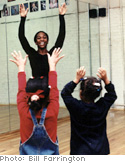On Your Toes

For Miss Pepper, ballet is more than girls in tights. It's a discipline, an identity, and a means of transforming a New York neighborhood.
Born Liza Springer some 30-odd years ago, Pepper—so nicknamed because of her intense, near-manic energy—runs several dance programs in New York City's Hunts Point. This low-income, mostly Puerto Rican neighborhood of the embattled South Bronx became an international symbol of urban blight in 1977 when then-president Jimmy Carter visited. While conditions have improved since then, the South Bronx is still per capita the poorest congressional district in the nation. One would think ballet classes for children would be low on the list of priorities for South Bronx families.But the transformative power of dance has made an impact in the neighborhood. "My class is really about discipline and self-esteem," says Pepper. "Dance changes their whole outlook on the world, which changes the whole community."
Pepper's most promising students have the opportunity to perform in her professional company, Contemporary Ballet Theatre (CBT). CBT's dancers are all ethnicities—African-American, Asian, Latino, Caucasian—and all sizes. "I want to bring different body types and different music to ballet," she says. One of her most popular pieces, "Praise," is set to gospel music, with dancers in purple choir robes fervently swaying, falling to their knees and throwing their arms open to the heavens, all through traditional ballet movements. She also incorporates hip-hop, African and jazz moves in her numbers—with the women on pointe. "How are we going to keep ballet alive if common folks can't find anything in it?" she asks.
Talking to Pepper, you get the sense that she's driven by a passion that took root way back. Her grandmother raised her in Panama until she was 10 years old. Then she moved to Washington to live with her parents. She began taking ballet, tap and African dance, and couldn't get enough. "I didn't have the perfect body; I was a chubby little Petunia with fat legs," says the 5-foot-1-inch dancer, whose body is now solid sinew after nearly two decades of training. "My teachers said, 'Miss Springer, you'll make a nice fat little ballerina,'" she recalls, rolling her eyes. "It traumatized me, but not in a negative way. It made me work harder. They could never take my love of dance away from me."
For many in the elite ballet world, the aim is to train the world's next great dancer. For Pepper, however, improving community is just as rewarding. "Even if they don't become professionals, the meticulousness that dance requires can help them develop the focus to be whatever they want to be—a mayor, the president. In one dance combination you have to think of a minimum of ten things: lengthen your legs, keep your shoulders down, chest lifted, remember the sequence, and watch the tempo, to name a few. That helps get you in the habit of using your mind. Dance is 90 percent mental."
What You Can Do
To learn more about the Contemporary Ballet Theater or their classes for children, visit: www.thepoint.org/dance/cbt.html or write:
The Point CDC
940 Garrison Avenue
Bronx, NY 10474
PH: 718-542-4139



